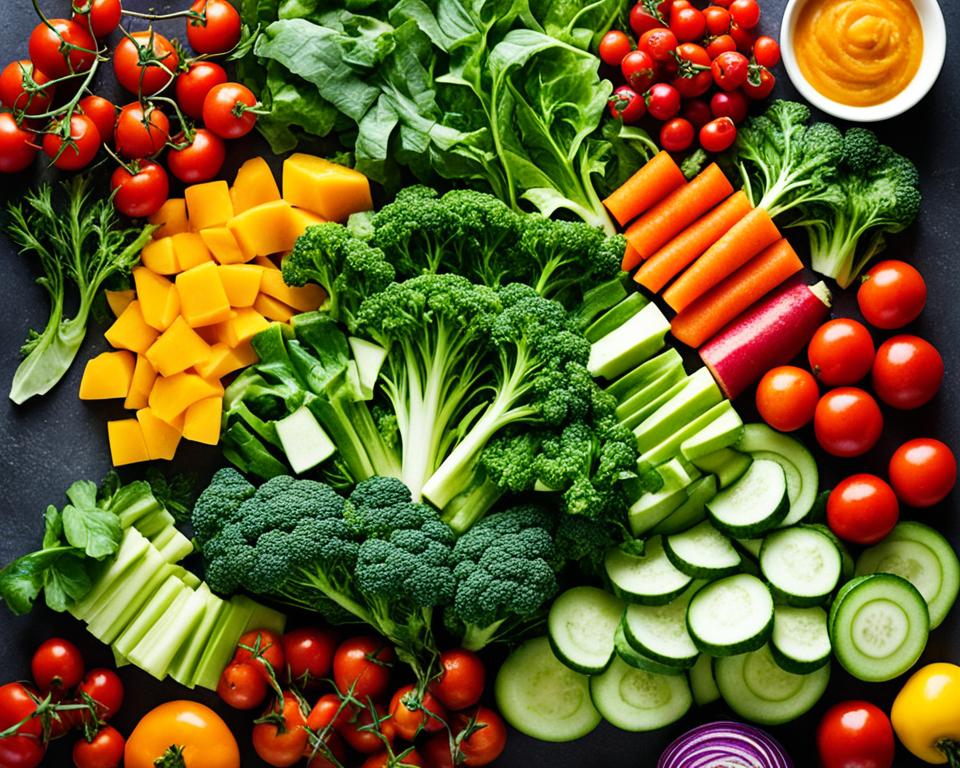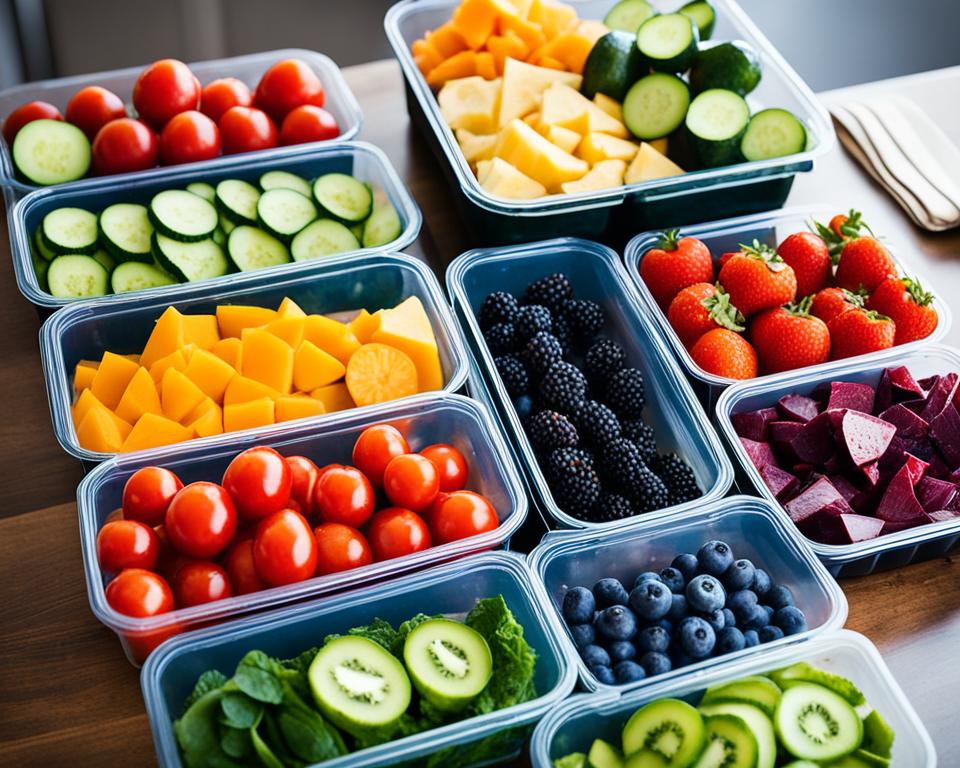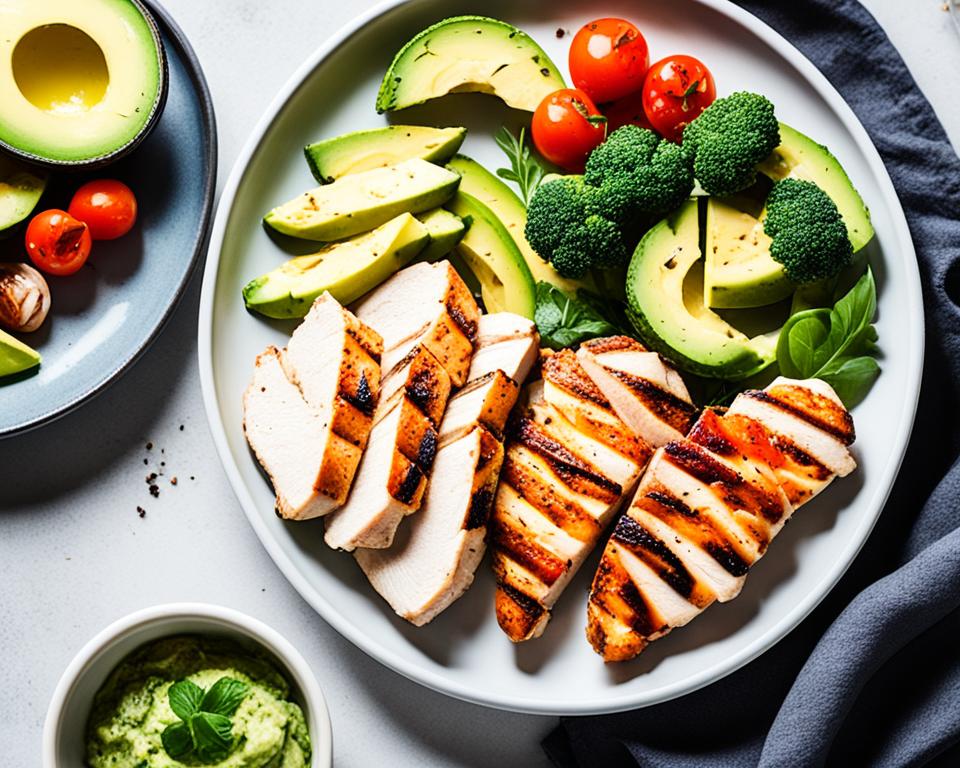Eating a wide variety of nutritious foods is essential for maintaining overall health and well-being. Nutrient-dense meals packed with essential vitamins, minerals, and antioxidants can boost your energy levels, support your immune system, and promote optimal functioning of your body. In this quick guide, we will explore nutrient-dense meal options that will help you achieve your wellness goals and maintain a balanced diet.
Key Takeaways
- Include a variety of fruits and berries in your meals to add flavor and essential nutrients.
- Lean meats are excellent sources of protein and other essential nutrients.
- Nuts and seeds are nutrient-rich snacks that provide healthy fats, fiber, and antioxidants.
- Vegetables offer concentrated sources of nutrition with vitamins, minerals, and fiber.
- Fish and seafood are high in omega-3 fatty acids, which are beneficial for heart and brain health.
Fruits and Berries – Healthy and Delicious
Fruits and berries are not only delicious but also highly nutritious additions to any diet. Packed with essential nutrients such as fiber, vitamins, and antioxidants, these natural wonders provide a wide range of health benefits. Incorporating a variety of fruits and berries into your meals can enhance their nutrient density and make every bite a delightful experience.
When it comes to healthy meal ideas, the options are endless with fruits and berries. Here are some examples of popular choices that you can easily include in your diet:
- Apples: A versatile fruit that can be enjoyed on its own, sliced in salads, or baked into healthy desserts.
- Avocados: Known for their creamy texture, avocados are packed with healthy fats and can be added to salads, smoothies, or used as a spread.
- Bananas: A convenient and portable snack with a natural sweetness that can be enjoyed on its own or added to smoothies and oatmeal.
- Blueberries: These tiny powerhouses are rich in antioxidants and can be added to yogurt, cereals, or enjoyed as a refreshing snack.
- Oranges: Bursting with vitamin C, oranges are a great addition to fruit salads, squeezed for fresh juice, or enjoyed as a refreshing snack.
- Strawberries: Juicy and vibrant, strawberries are perfect for adding a burst of flavor to salads, desserts, or as a topping for pancakes.
Benefits of fruits and berries:
Fruits and berries are not only delicious but also provide essential nutrients that support overall health and well-being. Here are some of the key benefits:
| Nutrient | Benefits |
|---|---|
| Fiber | Supports healthy digestion and keeps you feeling full for longer. |
| Vitamins | Provides a wide range of vitamins, such as vitamin C, which supports immune function. |
| Antioxidants | Helps protect cells from damage caused by free radicals and reduces the risk of chronic diseases. |
By incorporating these fruits and berries into your meals, you can elevate their nutritional value and enjoy a variety of flavors and textures. Whether you add them to smoothies, sprinkle them on top of your favorite dishes, or simply enjoy them as a healthy snack, fruits and berries are an excellent choice for optimizing your meal’s nutrient content.
Lean Meats – Protein Powerhouses
Lean, unprocessed meats like beef, chicken, and lamb are essential ingredients for high-nutrient recipes. They not only provide an excellent source of protein but also deliver a variety of other vital nutrients. Incorporating lean meats into your meals can help you meet your daily protein needs and support muscle growth and repair.
Lean beef is a popular choice for those looking to increase their protein intake while keeping their fat content low. It is rich in bioavailable iron, which is essential for oxygen transportation in the body, along with B vitamins that support various bodily functions.
Chicken breasts are another fantastic option for lean meats. They are low in fat and packed with high-quality protein, making them a staple in many healthy meal plans. Additionally, chicken breasts are versatile and can be prepared in various ways to suit different tastes and preferences.
Lamb and mutton also provide a nutritious protein source. They are rich in essential amino acids, which are the building blocks of protein. The consumption of lamb and mutton is a common practice worldwide, with various cultures including these meats in their traditional cuisines.
“Incorporating lean meats like beef, chicken, and lamb into your meals provides not only the protein your body needs but also a range of essential nutrients that support overall health and wellness.” – Nutritionist Jane Thompson
To ensure the quality and nutritional value of the lean meats you choose, opt for organic, grass-fed, or pasture-raised options whenever possible. This ensures that the animals were raised in a more natural environment, resulting in higher nutrient content in the meat.
Whether you’re grilling a juicy steak, roasting some chicken breasts, or preparing a delicious lamb dish, incorporating lean meats into your meals is a great way to boost your protein intake and enjoy nutrient-packed dishes.
Nuts and Seeds – Nutrient-Rich Snacks
Nuts and seeds are not only delicious but also packed with essential nutrients, making them excellent choices for nutritious snacking. These small powerhouses are high in unsaturated fats, fiber, and antioxidants, offering a wide range of health benefits. Including nuts and seeds in your diet can promote overall well-being and support a clean eating lifestyle.
There are numerous varieties of nuts and seeds that you can incorporate into your meals or enjoy as standalone snacks. Some popular options include:
- Almonds: These nuts are rich in vitamin E, healthy fats, and protein. They make a satisfying snack on their own or can be added to salads, smoothies, or homemade granola.
- Chia Seeds: Chia seeds are an excellent source of omega-3 fatty acids, fiber, and minerals. They can be sprinkled over yogurt, added to baked goods, or used as an egg substitute in vegan recipes.
- Coconuts: Coconuts offer a unique combination of healthy fats, fiber, and electrolytes. You can enjoy fresh coconut meat, use coconut oil for cooking, or add coconut flakes to your desserts or snacks.
- Macadamia Nuts: Macadamia nuts are rich in monounsaturated fats, which support heart health. They make a delicious and creamy addition to both sweet and savory recipes.
- Walnuts: Walnuts are packed with omega-3 fatty acids, antioxidants, and minerals. They can be enjoyed as a snack, added to oatmeal or smoothies, or incorporated into baked goods.
Including nuts and seeds in your clean eating recipes can provide essential nutrients and add a delightful crunch to your meals. Experiment with different combinations and flavors to create nutritious and satisfying dishes.
“Nuts and seeds are not only delicious but also packed with essential nutrients, making them excellent choices for nutritious snacking.”
Benefits of Including Nuts and Seeds in Your Diet:
1. Heart Health: Nuts and seeds contain healthy fats, such as monounsaturated and polyunsaturated fats, which are beneficial for heart health. They can help lower bad cholesterol levels and reduce the risk of heart disease.
2. Weight Management: Despite being calorie-dense, nuts and seeds can actually support weight management. They are rich in protein and fiber, which promote satiety and help control appetite, leading to better portion control.
3. Nutrient Density: Nuts and seeds are packed with essential nutrients, including vitamins, minerals, and antioxidants. Incorporating them into your meals can help ensure you meet your daily nutrient requirements.
4. Brain Health: Many nuts and seeds are rich in omega-3 fatty acids, which are important for brain health and cognitive function. Including them in your diet can support memory, focus, and overall brain health.
5. Energy Boost: Nuts and seeds provide a good source of energy due to their healthy fats and protein content. They make for excellent on-the-go snacks or additions to pre- or post-workout meals.
With their array of health benefits, incorporating nuts and seeds into your diet can contribute to a well-rounded and nutritious eating plan. They can be enjoyed as standalone snacks, added to meals and recipes, or used as flavorful toppings.
Vegetables – Concentrated Sources of Nutrition
Vegetables are a powerhouse of nutrients, packed with essential vitamins, minerals, fiber, and antioxidants. Including a variety of vegetables in your meals is a great way to optimize your nutrition and support optimal health. Whether you prefer leafy greens like kale, vibrant bell peppers, or versatile tomatoes, these nutrient-packed dishes can elevate your meals and provide a wide range of health benefits.
Here are some examples of vegetables that can enhance the nutritional content of your meals:
- Asparagus: Rich in folate, vitamins A and C, and dietary fiber, asparagus is a versatile vegetable that adds a delicious crunch to stir-fries and salads.
- Bell Peppers: With their vibrant colors and sweet flavor, bell peppers are a rich source of vitamin C, vitamin A, and antioxidants. They can be enjoyed raw in salads, roasted in Mediterranean dishes, or sautéed in Asian stir-fries.
- Broccoli: Packed with vitamin C, vitamin K, folate, and fiber, broccoli is a cruciferous vegetable that offers numerous health benefits. Add it to soups, stir-fries, or enjoy it steamed as a side dish.
- Carrots: Known for their high content of beta-carotene, carrots are a nutritious root vegetable that promotes healthy vision and immune function. Grate them for salads, roast them for a side dish, or enjoy them as a crunchy snack.
- Kale: A leafy green vegetable that is rich in vitamins A, C, and K, kale is a nutritional powerhouse. Use it as a base for salads, blend it into smoothies, or sauté it with garlic for a quick and healthy side dish.
- Onions: Packed with flavor, onions are not only delicious but also rich in antioxidants and sulfur compounds that have been linked to various health benefits. Add them to soups, stews, or sauté them for a flavorful base in many dishes.
- Tomatoes: Juicy and refreshing, tomatoes are a great source of vitamins A and C, as well as lycopene, an antioxidant known for its potential health benefits. Use them in salads, sandwiches, sauces, or enjoy them roasted for a burst of flavor.
By incorporating these nutrient-packed vegetables into your meals, you can create optimized nutrition meals that are both delicious and nourishing. The diverse range of colors, textures, and flavors offered by vegetables ensures that you receive a wide array of essential nutrients to support your overall well-being. So next time you prepare your meal, don’t forget to load up on these nutrient-dense vegetables!
Discover the Power of Vegetables:
Did you know that incorporating vegetables into your meals can help boost your immune system, improve digestion, and promote healthy weight management? Here are some of the key benefits of including vegetables in your diet:
“Vegetables are nature’s gift to our health. They provide essential vitamins, minerals, and antioxidants that support overall well-being.”

Integrating vegetables into your meals doesn’t have to be boring or tasteless. Experiment with different cooking methods, seasoning, and combinations to create nutrient-packed dishes that excite your taste buds and optimize your nutrition. Enjoy the natural flavors and textures of vegetables while reaping the health benefits they provide!
Fish and Seafood – Omega-3 Powerhouses
Fish and seafood are essential components of balanced diet plans, as they are rich sources of omega-3 fatty acids and other beneficial nutrients. Including fish and seafood in your meals can provide numerous health benefits, such as supporting heart health and brain function. Incorporating high-nutrient recipes that feature fish and seafood can help you achieve a well-rounded and nutritious diet.
There are various types of fish and seafood that you can incorporate into your diet. Some examples include:
- Salmon: This fatty fish is known for its high omega-3 content and is a versatile ingredient in many high-nutrient recipes.
- Sardines: These small fish are packed with omega-3 fatty acids, calcium, and vitamin D, making them a nutritious choice for seafood lovers.
- Shellfish: Varieties like shrimp, crab, and lobster provide protein, essential fats, and a range of vitamins and minerals.
- Trout: Trout is an excellent source of omega-3 fatty acids and protein, making it a healthy addition to your balanced diet plans.
- Tuna: This type of fish is rich in omega-3 fatty acids and can be incorporated into various dishes, such as salads or sandwiches.
Including fish and seafood in your balanced diet plans not only adds delicious flavors to your meals but also ensures you receive essential nutrients. The table below summarizes the nutritional benefits of common types of fish and seafood:
| Types of Fish and Seafood | Omega-3 Content | Protein | Other Nutrients |
|---|---|---|---|
| Salmon | High | High | Vitamin D, Vitamin B12, Selenium |
| Sardines | High | Moderate | Calcium, Vitamin D |
| Shellfish (Shrimp, Crab, Lobster) | Low | High | Iron, Zinc, Vitamin B12 |
| Trout | Moderate | High | Omega-3 fatty acids, Vitamin D, Vitamin B12 |
| Tuna | Moderate | High | Potassium, Vitamin B12 |
By incorporating fish and seafood into your high-nutrient recipes, you can enjoy delicious meals while reaping the benefits of omega-3 fatty acids and other valuable nutrients. Whether grilled, baked, or sautéed, fish and seafood offer a wide range of flavors and textures to keep your meals exciting and nutritious.
Grains – Nutritional Powerhouses
Whole grains are essential for maintaining a balanced diet plan and achieving wholesome and nourishing meals. Incorporating grains such as brown rice, oats, and quinoa into your diet can provide a wide range of health benefits. These grains are packed with fiber, vitamins, minerals, and other essential nutrients that support overall well-being.
High in fiber, whole grains promote healthy digestion and contribute to a feeling of fullness, making them an excellent choice for weight management and maintaining a healthy weight. Additionally, the fiber in grains supports proper digestion by preventing constipation and promoting regular bowel movements.
Not only do whole grains provide sustained energy, but they also offer an array of vitamins and minerals that contribute to optimal health. They are rich in B vitamins, such as thiamin, riboflavin, and niacin, which play important roles in energy production, brain function, and cellular health. Additionally, whole grains contain minerals like magnesium, selenium, and zinc, which are crucial for various bodily functions.
To give you a visual representation of the nutrient content of different whole grains, refer to the table below:
| Grain | Fiber (g) | Protein (g) | Vitamin B6 (mg) | Magnesium (mg) |
|---|---|---|---|---|
| Brown Rice | 3.5 | 7.9 | 0.3 | 43 |
| Oats | 4 | 11 | 0.3 | 158 |
| Quinoa | 2.8 | 4.4 | 0.2 | 64 |
Enjoying a variety of whole grain options in your daily meals can provide the necessary nutrients for a well-rounded and nutritious diet. From a comforting bowl of oatmeal for breakfast to a side of brown rice with dinner, there are numerous ways to incorporate these nutritional powerhouses into your everyday meals.
Choose whole grain products whenever possible, such as whole wheat bread, whole grain pasta, and whole grain cereals. These options retain the bran, germ, and endosperm of the grain, ensuring you benefit from all the nutrients they offer. Remember to check food labels and opt for products with whole grains as one of the top ingredients.
Breads – Healthy Choices
When it comes to selecting bread products for your healthy meals, whole grain breads are a nutritious choice. They offer a range of benefits that can help optimize your nutrition and promote overall well-being.
When choosing bread, look for options that are high in dietary fiber and contain minimal added sugar. These breads provide a good source of essential nutrients, fiber, and a satisfying taste. (Note: Check out the table below for a comparison of different types of whole grain breads and their nutritional value.)
| Bread Type | Key Features | Nutritional Value |
|---|---|---|
| Ezekiel Bread | Made from organic sprouted whole grains | Rich in fiber, protein, vitamins, and minerals |
| Multigrain Bread | Contains a mixture of whole grains | Provides a variety of nutrients and fiber |
| Sourdough Bread | Fermented bread with a tangy flavor | Easier to digest and may have lower glycemic index |
Homemade bread is another great option, as you can control the ingredients and baking process. By using organic sprouted whole grains or whole grain flours, you can create bread that is not only healthy but also delicious. (Note: Check out the image below for a visual representation of different types of whole grain breads.)
Including whole grain breads in your meals can provide you with the necessary nutrients and fiber to support a balanced diet. Whether you enjoy them as a toast for breakfast, in sandwiches for lunch, or as a side with your dinner, these healthy bread choices are a versatile addition to any optimized nutrition meal plan.
Legumes – Plant-Based Protein and Fiber
Incorporating legumes into your balanced diet plans can provide numerous health benefits. Legumes, such as green beans, kidney beans, lentils, and peanuts, are rich sources of plant-based protein and fiber. They are an excellent choice for individuals following vegetarian or vegan meal plans, as they offer essential nutrients typically found in animal products.
Legumes not only provide high-quality protein but also contain a good amount of dietary fiber. This combination helps promote satiety, making legumes a valuable addition to nutrient-rich meal plans. By including legumes in your meals, you can feel fuller for longer, which can be beneficial for weight management and overall energy balance.
Moreover, legumes offer various vitamins and minerals that contribute to a well-rounded diet. They contain important nutrients such as folate, iron, magnesium, and potassium, which are essential for proper bodily functions. These nutrient-rich foods can help support overall health and well-being.
To highlight the nutritional value of legumes, here is a quick comparison of the protein and fiber content in some common legumes:
| Legume | Protein (per 100g) | Fiber (per 100g) |
|---|---|---|
| Green beans | 1.8g | 2.7g |
| Kidney beans | 8.3g | 6.4g |
| Lentils | 9.0g | 7.9g |
| Peanuts | 25.8g | 8.5g |
As seen in the table, legumes offer a significant amount of both protein and fiber. Incorporating legumes into your meals can contribute to meeting your protein needs, especially for individuals following plant-based diets. Additionally, legumes’ fiber content supports healthy digestion and can help maintain a balanced gut microbiome.
Recipe Idea: Lentil Salad with Roasted Vegetables
Here’s a delicious and nutrient-packed recipe to inspire you:
- Preheat your oven to 400°F (200°C).
- In a large mixing bowl, toss 2 cups of mixed vegetables, such as bell peppers, zucchini, and cherry tomatoes, with 2 tablespoons of olive oil, 1 teaspoon of dried herbs (such as thyme or rosemary), and a pinch of salt and pepper.
- Spread the vegetables onto a baking sheet and roast for 20-25 minutes, or until they are tender and slightly caramelized.
- In the meantime, cook 1 cup of lentils according to the package instructions. Drain and set aside.
- In a small bowl, whisk together 2 tablespoons of olive oil, 1 tablespoon of freshly squeezed lemon juice, 1 teaspoon of Dijon mustard, and a pinch of salt and pepper to create a simple dressing.
- In a large salad bowl, combine the roasted vegetables, cooked lentils, and dressing. Toss gently to coat evenly.
- Garnish with a handful of fresh herbs, such as parsley or basil, and serve.
This refreshing lentil salad not only showcases the flavors of roasted vegetables but also provides a balanced mix of plant-based protein, fiber, and essential nutrients.

Adding legumes to your nutrient-rich meal plans can help you create balanced and satisfying dishes. Whether you enjoy them in hearty soups, flavorful stews, or refreshing salads, legumes offer a versatile and nourishing option for plant-based protein and fiber.
Conclusion
Nutrient-dense meals are the cornerstone of a healthy lifestyle, providing the essential nutrients our bodies need to thrive. By incorporating a diverse range of fruits, vegetables, lean meats, nuts, seeds, fish, whole grains, and legumes into your daily diet, you can optimize your nutrition and achieve a well-balanced, nourishing eating plan.
When it comes to nutrient-dense meals, prioritizing whole, unprocessed foods is key. Choose fresh, seasonal produce, and opt for lean cuts of meat and fish. Incorporate a variety of grains such as brown rice, oats, and quinoa, and enjoy the wholesome goodness of nuts and seeds. Experiment with clean eating recipes that utilize these ingredients to create delicious meals that are as nutritious as they are flavorful.
Remember, optimizing your nutrition doesn’t have to be complicated. By making small changes to your eating habits and incorporating nutrient-dense meals into your daily routine, you can fuel your body with the essential nutrients it needs for optimal health and wellness. So, why wait? Start your journey towards optimized nutrition and clean eating today!
FAQ
What are nutrient-dense meals?
Nutrient-dense meals are meals that are packed with a high amount of essential nutrients per calorie. These meals typically consist of a wide variety of fruits, vegetables, lean meats, nuts, seeds, fish, whole grains, and legumes. They provide a balanced combination of vitamins, minerals, fiber, protein, and healthy fats.
How can I incorporate fruits and berries into my meals?
You can incorporate fruits and berries into your meals by adding them to salads, smoothies, yogurt, or oatmeal. They can also be enjoyed as snacks or used as toppings for desserts. Fruits and berries add natural sweetness, vibrant colors, and a range of essential nutrients to your meals.
What are some lean meats that I can include in my meals?
Some examples of lean meats that you can include in your meals are beef, chicken, and lamb. These meats are excellent sources of protein and other essential nutrients. They can be grilled, baked, or stir-fried to create delicious and protein-packed main dishes.
How can I incorporate nuts and seeds into my meals?
You can incorporate nuts and seeds into your meals by adding them to salads, stir-fries, or baked goods. They can also be enjoyed as snacks or used as toppings for yogurt or cereal. Nuts and seeds provide a satisfying crunch, healthy fats, and a variety of essential nutrients.
What are some ways to incorporate vegetables into my meals?
You can incorporate vegetables into your meals by sautéing them, roasting them, or adding them to soups, stews, or stir-fries. They can also be enjoyed raw in salads or as a side dish. Vegetables provide a wide range of vitamins, minerals, fiber, and antioxidants to support overall health.
How can I include fish and seafood in my meals?
You can include fish and seafood in your meals by grilling, baking, or steaming them. They can be used as the main protein source in dishes like fish tacos, seafood pasta, or grilled salmon. Fish and seafood are rich in omega-3 fatty acids and other beneficial nutrients for heart health and brain function.
What are some examples of whole grains that I can include in my meals?
Some examples of whole grains that you can include in your meals are brown rice, oats, and quinoa. These grains can be used as the base for grain bowls, added to soups or salads, or used as a side dish. Whole grains provide fiber, vitamins, minerals, and sustained energy.
What should I look for when selecting bread products for my meals?
When selecting bread products for your meals, look for options with high dietary fiber and minimal added sugar. Homemade bread or bread made from organic sprouted whole grains, such as Ezekiel bread, can also be great choices. These breads provide nutrients, fiber, and a satisfying taste.
How can I include legumes in my meals?
You can include legumes in your meals by adding them to soups, stews, salads, or side dishes. They can also be used as the main protein source in dishes like lentil curry or chickpea salad. Legumes are excellent sources of plant-based protein and fiber, as well as various vitamins and minerals.
How do nutrient-dense meals support overall wellness?
Nutrient-dense meals support overall wellness by providing a wide range of essential nutrients that support optimal health. These meals can help meet your daily nutrient needs, support healthy digestion, promote satiety, and provide sustained energy throughout the day. Nutrient-dense meals play a crucial role in a balanced and nourishing eating plan.





